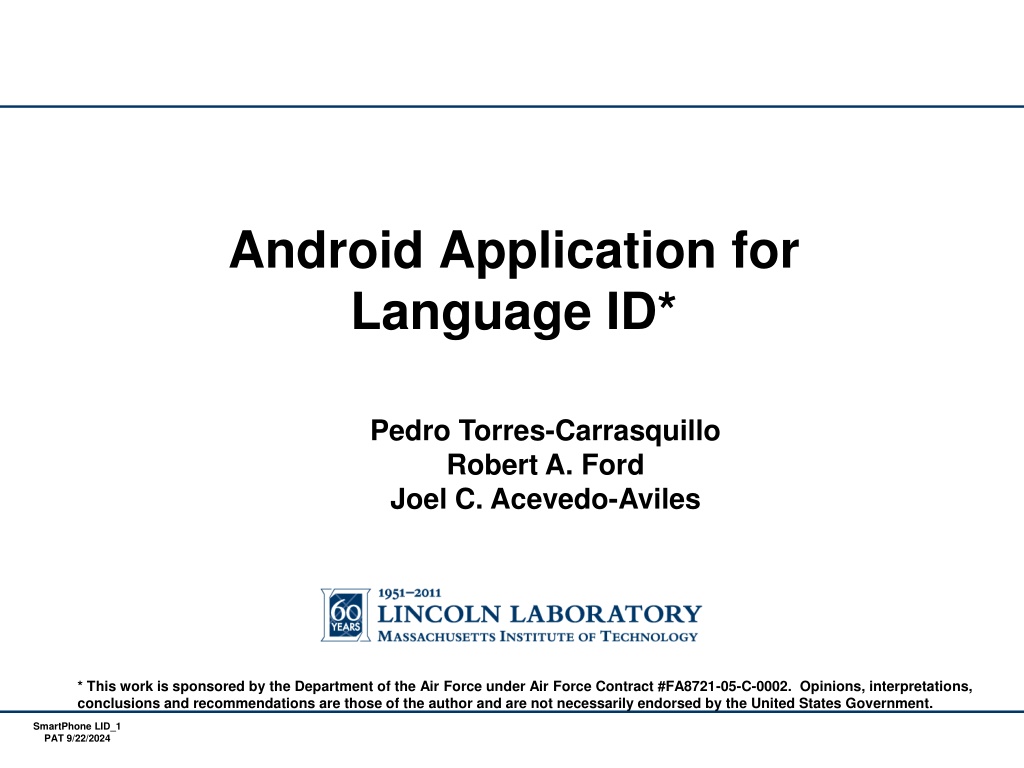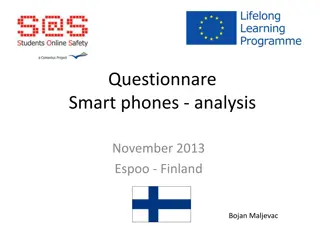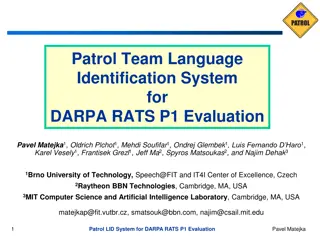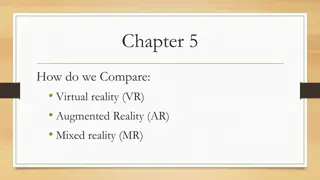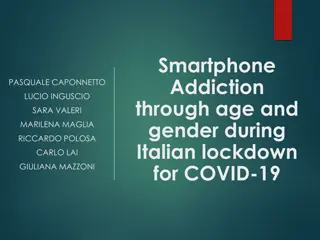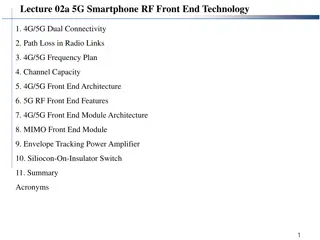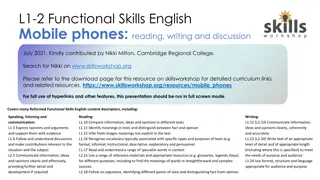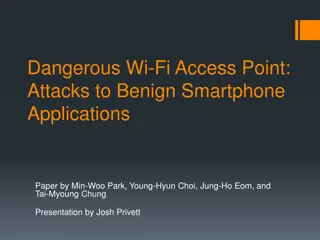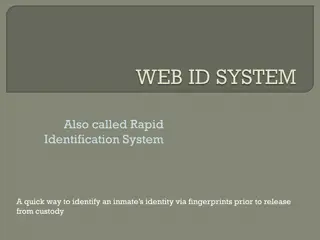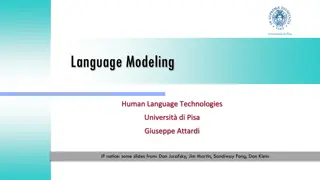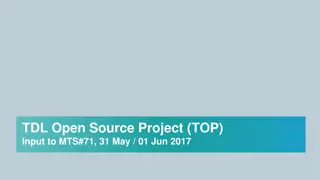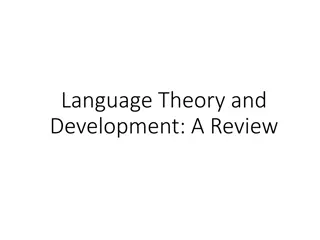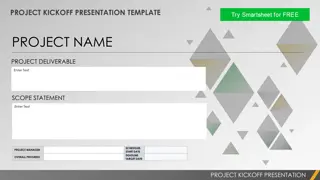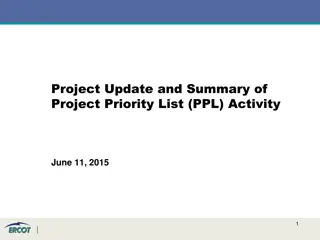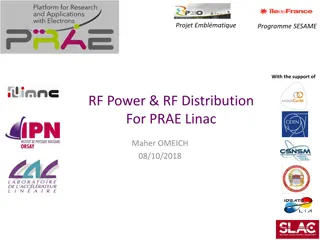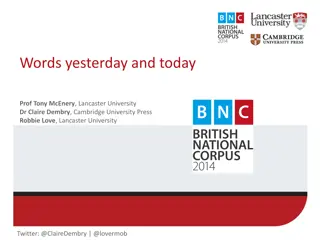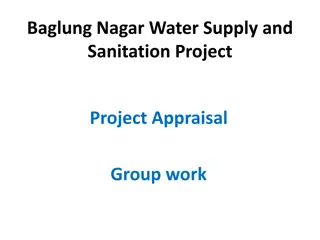Smartphone Language Identification System: Project Overview
Implementation of a Language Identification (LID) system on Android smartphones to handle emergency language service requests efficiently. The project aims to evaluate performance across devices, develop a prototype app, and automate language recognition without human intervention, enhancing communication in emergency situations.
Download Presentation

Please find below an Image/Link to download the presentation.
The content on the website is provided AS IS for your information and personal use only. It may not be sold, licensed, or shared on other websites without obtaining consent from the author. Download presentation by click this link. If you encounter any issues during the download, it is possible that the publisher has removed the file from their server.
E N D
Presentation Transcript
Android Application for Language ID* Pedro Torres-Carrasquillo Robert A. Ford Joel C. Acevedo-Aviles * This work is sponsored by the Department of the Air Force under Air Force Contract #FA8721-05-C-0002. Opinions, interpretations, conclusions and recommendations are those of the author and are not necessarily endorsed by the United States Government. SmartPhone LID_1 PAT 9/22/2024
Outline Motivation Automatic Language Identification (LID) SmartPhone Implementation System Performance Conclusions and Future Work Demo SmartPhone LID_2 PAT 9/22/2024
Motivation Any unplanned interaction with someone who does not speak our language requires an interpreter Language identification is needed first Recent example in San Diego Harbor (March 27, 2011) 26-foot sailboat capsized First responders did not recognize language investigators had to bring in interpreters to speak to them, San Diego Fire-Rescue spokesman Maurice Luque said. He did not know what language they spoke. SmartPhone LID_3 PAT 9/22/2024
Applications Language-based data filtering Pre-processing for automated speech applications such as machine translation and speech recognition Requesting human interpreters for emergency situations Our focus is to develop a Smartphone application that addresses the latter scenario (i.e. routing language service requests in emergency situations) SmartPhone LID_4 PAT 9/22/2024
Project Goals Implement a LID system on an Android based Smartphone Evaluate tradeoffs between computational complexity and performance across several phones Evaluate performance of in-phone LID system with field testing Develop a prototype application that integrates existing Smartphone capabilities with LID to quickly and efficiently route language service requests SmartPhone LID_5 PAT 9/22/2024
Automatic Language Identification (LID) Automatic language identification is the process of determining the language being spoken in a speech utterance without human intervention Closed-set identification Prior knowledge of all classes Open set identification Out of set class Arabic Arabic Which language is this? Which language is this? ? ? ? ? ? ? ? ? English English ? ? ? ? Farsi Farsi ? ? Focus: Closed-set ID None of the above SmartPhone LID_6 PAT 9/22/2024
LID System Architecture Language identification task: Find messages spoken in a target language Training Spanish Training Algorithm Feature Extraction English German Training speech utterances in known languages Set of models: one model per language Recognition Recognition Algorithm Feature Extraction It s German! Speech utterance in unknown language Recognition Output SmartPhone LID_7 PAT 9/22/2024
LID System Feature Processing 10ms .. . Feature Vectors 3.4 3.6 2.1 0.0 -0.3 0.1 0.2 . . . . . . -0.1 3.4 3.6 2.1 0.0 -0.3 0.1 0.2 3.4 3.6 2.1 . . . 0.1 3.4 3.6 2.1 . . . . . . . . . . 0.2 Short-time Spectral Magnitude Cepstral Analysis Channel Compensation Deltas Spectral Analysis Generate frequency component information through Short-Time Fourier Transform Cepstral Analysis Separates frequency information that is characteristic of a language from what is common across all languages considered (7 features) Channel Compensation Reduces the effects of differences across channels (landline vs cell phone) Deltas Encode temporal variation of Cepstral features by computing the differences among neighboring frames SmartPhone LID_8 PAT 9/22/2024
LID System Gaussian Mixture Modeling Gaussian Mixture Model (GMM) Almost any continuous probability distribution can be approximated by a linear combination of Gaussians Each language is modeled as a probability distribution over the feature variables Mixture Weight Variance Mean SmartPhone LID_9 PAT 9/22/2024
Android LID System Architecture Standard wave file (PCM) 16 bits/sample 8kHz sample rate As the user speaks, streaming audio is sent to the LID component for processing The LID system consists of previously developed technology by the HLT group at Lincoln Laboratory (C++) Android s Native Development Kit (NDK) allow us to make use of C++ native code SmartPhone LID_10 PAT 9/22/2024
Android Screenshots/Demo User speaks for up to 30s Detected language is displayed Main screen When enough speech captured User presses button App starts capturing user s speech and does not stop until final decision is displayed When a minimum of audio is captured, it is processed Minimum audio is a system parameter; currently 7-seconds A score is generated for each language If language score > preset threshold Decision is displayed, otherwise Score all audio captured until this point SmartPhone LID_11 PAT 9/22/2024
System performance versus model complexity Computer Simulation Error Rate vs Complexity 25 20 Classification Error Rate (%) 15 10 5 0 64 128 256 512 1024 2048 Mixture order (model complexity) Five-Language task: Arabic, Cantonese, English, Mandarin, Spanish Test sample nominal length: 30s Task: closed-set ID SmartPhone LID_12 PAT 9/22/2024
SmartPhone configurations Multiple phones were evaluated Older platform (HTC Magic) Newer (Atrix) HTC Magic Samsung Nexus S HTC Sensation LG G2x, Motorola Atrix Tegra 2 CPU Qualcomm MSM7200A ARM 11 528 MHz 90 nm no 2009 1 Hummingbird Qualcomm MSM 8x60 Scorpion 1.2 GHz 45 nm partial 2011 16 Processor design Clock Process Out of Order Execution Year introduced Relative performance Cortex A8 1 GHz 45 nm no 2011 6 Cortex A9 1 GHz 40 nm yes 2011 18 SmartPhone LID_13 PAT 9/22/2024
Average execution time versus model order In-SmartPhone Evaluation Task: 5-language closed-set Id Test sample average duration: 30s Averaged over 4 test samples SmartPhone LID_14 PAT 9/22/2024
Average execution time versus model order In-SmartPhone Evaluation Task: 5-language closed-set Id Test sample average duration: 30s Averaged over 4 test samples SmartPhone LID_15 PAT 9/22/2024
Average execution time for different tasks In-SmartPhone Evaluation Comparison in execution time between 5 and 50- language task Phone 5 50 Languages 16.9s Languages 21s Nexus S (Hummingbird) Motorola Atrix Fixed model complexity 2048 7.9s 9s HTC 10.7s 11s 30-sec samples Droid X2 5.2s 8.6s LGE G2X 7.9s 9s Small overhead in computation since in both cases the language independent model is scored and takes most of the processing time SmartPhone LID_16 PAT 9/22/2024
System performance Benchmark Classification Error Rate: 9.1% Computer LID system Development Set In-phone evaluation Classification Error Rate: ~20% 7 languages Arabic, Mandarin, Vietnamese, Hindi, Russian, Spanish, Turkish Half of captured segments < 10s Potential issue with mismatch between 30s system training and amount of speech provided by users SmartPhone LID_17 PAT 9/22/2024
System performance Impact of test segment duration Matched system Train and test samples of same duration Mismatched system Trained on full sample length Speech (s) Classification error rate (%) 28.1 16.8 10.2 9.4 9.2 9.1 Speech (s) Classification error rate (%) 29.8 17.6 12.6 10.3 9.3 9.1 6 12 18 24 30 6 12 18 24 30 Full sample Full sample SmartPhone LID_18 PAT 9/22/2024
Conclusions and Summary State of the art LID technology has been implemented in Android platform Successful evaluation conducted over multiple handsets Newer handset perform in real time Additional data is needed to support more in-phone testing SmartPhone LID_19 PAT 9/22/2024
Future Work Implementation of robustness techniques to enhance mismatch between training data and telephone Can performance be improved by using multiple systems in combination? Is current speech activity detection aggressive enough? Use speech time instead of audio time Compensate for shorter durations Likely main current source of mismatch Evaluate power consumption/battery life for field use Study the open-set problem Leverage current implementation to extend to speaker identification SmartPhone LID_20 PAT 9/22/2024
